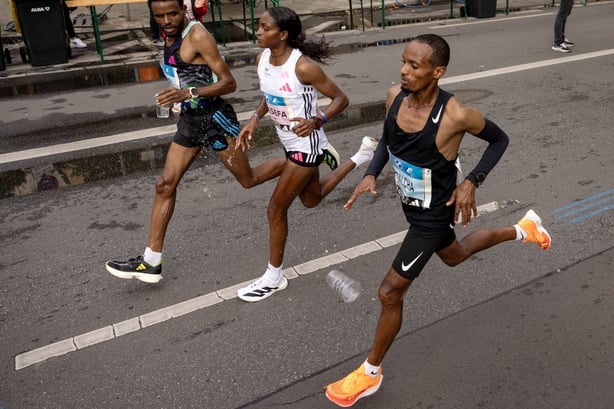The Dublin Marathon is only a few weeks away and people up and down the country are no doubt getting their miles in ahead of the big race.
When it comes to running a marathon, kit is almost as important as mindset and training, and trainers have come on in leaps and bounds, if you will, in recent years. From aerodynamic silhouettes and state-of-the-art cushioning, to carbon plates in the sole, there are seemingly endless innovations in the running world for helping you go that little bit further.
Many of us are content with our old reliable, beat up trainers, but how much would you be willing to spend on a pair of runners if they gave you a chance to improve your PB?

A keen runner himself, Brian O'Connell, RTÉ Reporter, researched the latest pair of runners making headlines and joined Today with Claire Byrne to share his findings.
Carbon shoes have been around for a number of years, which have a special kind of foam in the sole and provide a "rocking" feeling when running, he said, as well as a carbon plate embedded within.
"Essentially, this carbon plate will absorb the energy when you hit the ground and it's meant to push you back up off the ground, so the idea in theory [is] you should run faster and you should recover quicker."
Adidas's new Adizero Adios Pro Evo 1s are the latest innovation to stagger the racing world. Although not available in shops yet, they have been making headlines, especially in the wake of the winner of the Berlin Marathon, Tigst Assefa, smashing the women's marathon record by two minutes while wearing the shoes.
"It's about 40% lighter than most of these super shoes available. It's developed, they tell us, in training camps in Kenya, [with] all sorts of cutting edge design. They have this foam technology", O'Connell said.
But here's the kick: these are designed to be worn for just one marathon, with maybe a recovery run here or there.

"All of these carbon runners you buy will have a limit, so you're looking at, for many of them, about 250 to maybe 500 miles and then after that the carbon doesn't really work anymore so you have to replace them anyway."
However, he noted that most carbon shoes on the market would cost between €150 and €300 at the top end. "So I suppose the question is, are these new shoes the greatest marketing ploy in running history, or do they actually work?"
O'Connell spoke to Dustin Joubert, an assistant professor at St. Edward's University, who had put several models of these carbon shoes to the test in his lab. His team looked at male runners who ran at a six-minute mile pace, and found between 3% to 4% running economy benefits on average.
For someone running eight-minute mile pace, they saw reduced benefits, but noted there were still benefits to wearing the carbon shoes.

As for recovery, he noted that if you didn't have the money to spend on carbon plated shoes, there are other ways to train smarter and harder to reap similar benefits.
O'Connor also spoke to Mark Hanrahan said that using them was like "running on springs", adding, "they just make a world, a world of difference".
"It throws you forward. You could do a half-marathon in the old traditional racing shoes and you'd probably be sore for a week, whereas if you ran the half-marathon in the new 'magic shoes', as we call them, you probably could get up the next day and do another half marathon."
For more, listen back to the full interview above.

